Karolyi: English A19
1.c4 Nf6 2.Nc3 e6 3.e4
c5 4.e5 Ng8 5.Nf3 Nc6 6.d4 cxd4 7.Nxd4 Nxe5
|
 |
|
After 3…c5 4.e5 in the Mikenas System
things start to happen, because White sacrifices
a pawn and gets in return good play on the white
squares. The author presents a repertoire from
White’s point of view. |
Skembris:
English A29
1.c4 e5 2.Nc3 Nf6 3.g3
d5 4.cxd5 Nxd5 5.Bg2 Nb6 6.Nf3 Nc6 7.0-0 Be7 8.a4!? a5
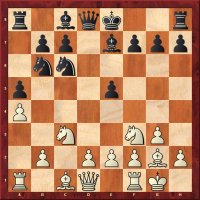 |
|
The author sets about rehabilitating the move
8.a4 which has been written off as dubious.
If White reacts energetically, especially with
the temporary pawn sacrifice 9.d4, this
should be successful and Black has to struggle
for equality. |
Marin: Dutch Defence A81
1.d4
f5 2.g3 Nf6 3.Bg2 g6 4.Nh3 Bg7 5.Nf4
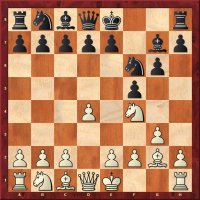 |
|
White wants to push his h-pawn to h6 and has
been very successful with this idea. But Marin
looks at it all from Black’s point of view and
does his level best to find an antidote –
successfully! |
Stohl: Caro-Kann B10
1.e4
c6 2.c4 d5 3.cxd5 cxd5 4.exd5 Nf6 5.Qa4+
 |
|
This side line is very venomous – if Black does
not know what he is doing, he will end up stuck
with a pawn deficit. White’s setup can even be
employed against those who play the Slav,
because it all starts with 1.c4 c6 2.e4. |
Kovalov: Sicilian B42
1.e4
c5 2.Nf3 e6 3.d4 cxd4 4.Nxd4 a6 5.Bd3 Bc5 6.Nb3 Ba7
7.Nc3 Nc6 8.Qg4 Nf6 9.Qg3 d6
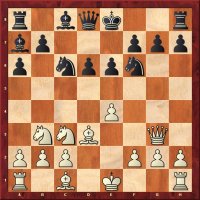 |
|
Can White get an advantage when faced with the
tempting but also daring idea of …Bc5
and …Ba7?
Our author is analysing from Black’s point of
view, but nevertheless concludes that with
accurate play White will achieve a slight
superiority. |
Grivas: Sicilian B51
1.e4
c5 2.Nf3 Nc6 (d6) 3.Bb5 d6 (Nc6)
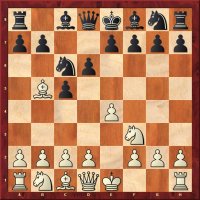 |
|
The black setup can be used both after 2…d6
and after 2…Nc6.
White gets nowhere with 4.Bxc6+,
because later he cannot manage without d2-d4.
Even in the main line after 4.0-0
Bd7
White cannot achieve an advantage. |
Postny: Sicilian B96
1.e4
c5 2.Nf3 d6 3.d4 cxd4 4.Nxd4 Nf6 5.Nc3 a6 6.Bg5 e6 7.f4
Nbd7 8.Bc4
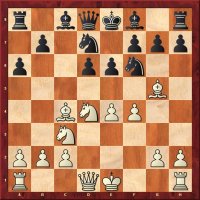 |
|
What is attractive about 8.Bc4
is above all that Black, if he plays the usual
moves, soon falls behind, Only 8…Qb6!
is correct. Postny shows that after that White
can achieve no more than equality. |
Kritz: French Defence C16
1.e4 e6 2.d4 d5 3.Nc3
Bb4 4.e5 Ne7 5.a3 Bxc3+ 6.bxc3 b6!?
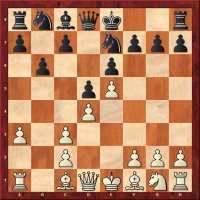 |
|
Here White must react energetically, i.e. with
7.Qg4,
or else next comes…Ba6
with equality. The author gives glimpses of the
correct way to play for both sides. If the order
of moves is correct, he can see an advantage for
Black. |
Marin: Ruy Lopez C93
1.e4
e5 2.Nf3 Nc6 3.Bb5 a6 4.Ba4 Nf6 5.0-0 Be7 6.Re1 b5 7.Bb3
d6 8.c3 0-0 9.h3 h6 10.d4 Re8 11.Nbd2 Bf8 12.Nf1 Bb7
13.Ng3 Na5 14.Bc2 Nc4
 |
|
The third and last article on the Smyslov
variation: 9…h6 looks into the move
12…Bb7.
In his detailed analysis Marin comes to the
conclusion that the move does not equalise
completely. For that reason he would prefer
12…Bd7
as examined in CBM 129. |
Kuzmin: Queen's Pawn Opening D02
1.d4
Nf6 2.Nf3 g6 3.Nbd2 d5 4.e3 Bg7 5.b4 0-0
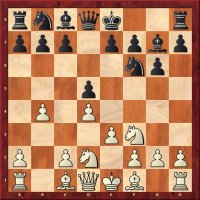 |
|
The author calls this an Anti-Grünfeld System.
In fact, the point of it is to render as
difficult as possible the move …c5 which is so
typical of the Grünfeld and in addition the
white knight is better on d2 than on c3. |
Krasenkow: Grünfeld Defence D81
1.d4
Nf6 2.c4 g6 3.Nc3 d5 4.Qb3 dxc4 5.Qxc4 Bg7 6.e4 0-0
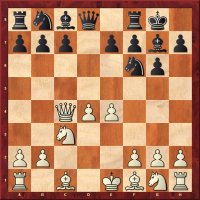 |
|
Here the idea is to hold back the move
Nf3,
which naturally excludes variations for Black
with …Bg4.
The variation is still under discussion at the
top level and obviously the last word has not
yet been said about it. |